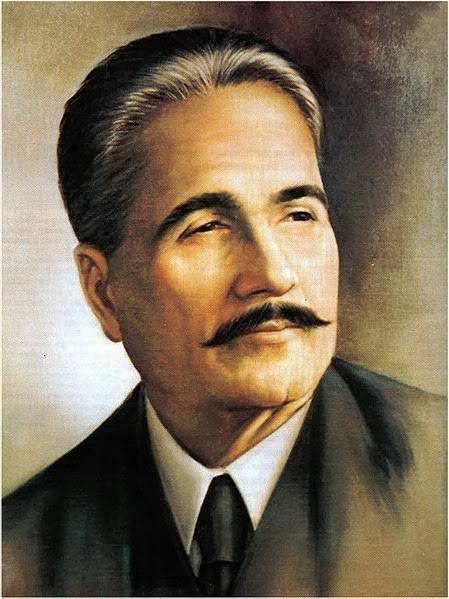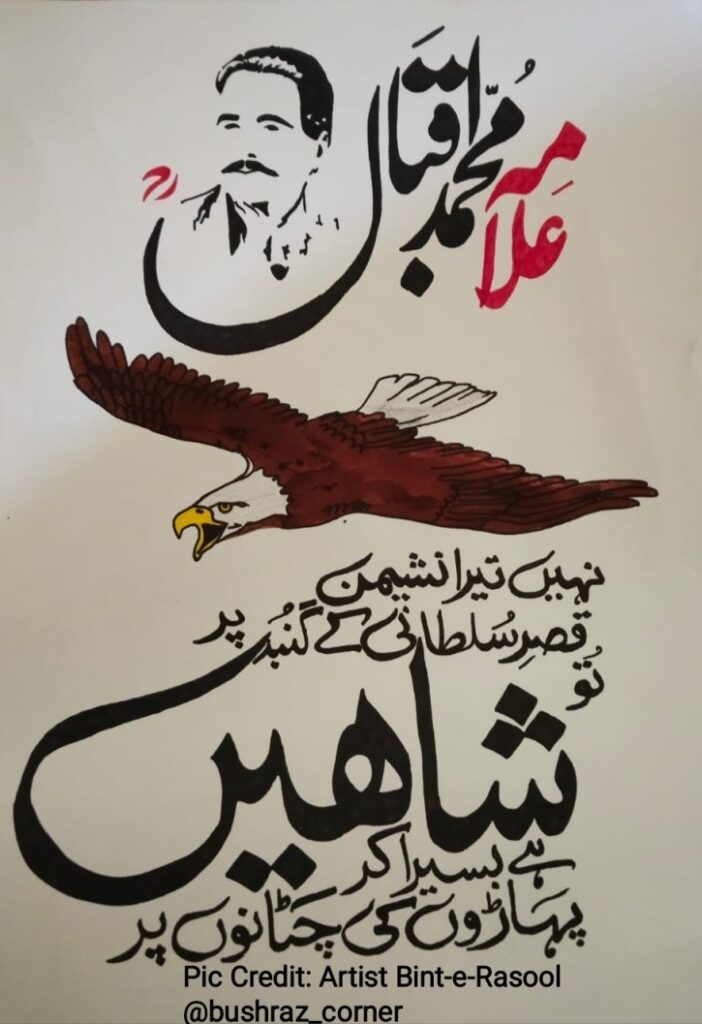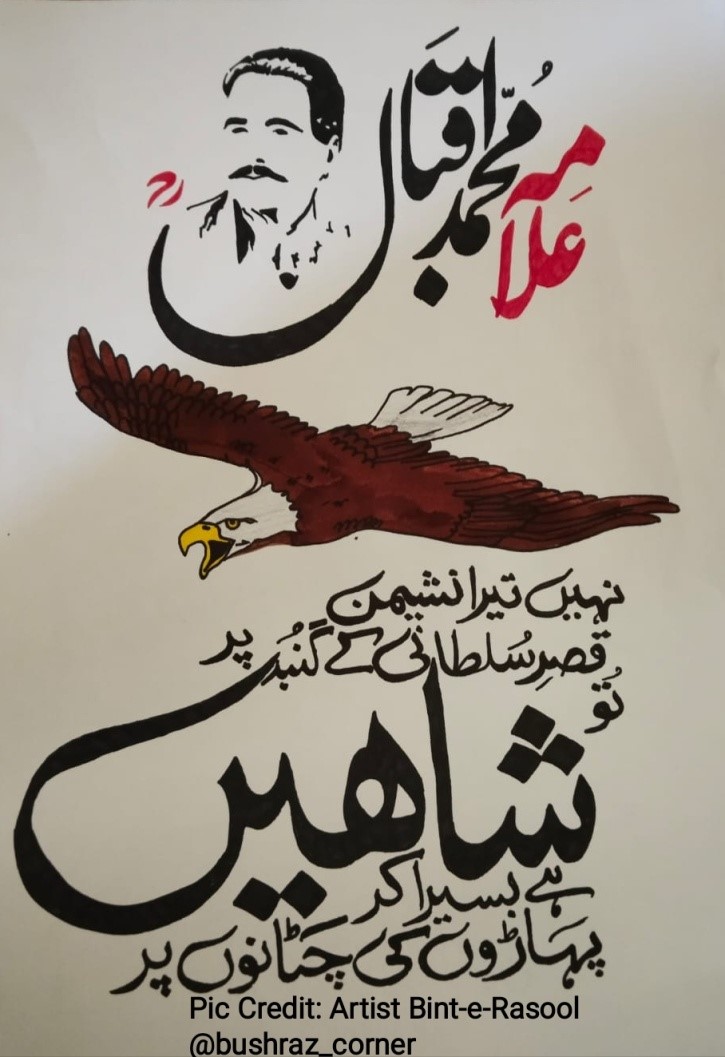The profound literary odyssey of Allama Iqbal transcends his verses, inspiring self-discovery, and leaving an indelible mark on the realms of poetry and philosophy.
By Aubaid Ahmad Akhoon
We see many great poets creating beautiful poems among us. They might write in different styles like masnavi, qaseeda, or rubai. These literary masterpieces, spanning the realms of both romance and reality, leave an enduring impact with a malleability that imparts a profound essence. As we immerse ourselves in the verses of these poets, certain lines become indelibly etched in our minds, and the poets themselves ascend to the echelons of our favorites. Notably, the verses of the spiritual luminary, Allama Sir Muhammad Iqbal, have evolved into a profound wellspring of inspiration for me.
While going through the realm of Allama Iqbal’s poetry, his verses offer sagacious counsel, and his ghazals stand as exemplary works destined to be enshrined in memory for as long as the world endures. Allama Iqbal’s thought-provoking verses resonate with a profound call, urging individuals to plumb the depths of their own consciousness and uncover the true purpose of their lives. His poetry eloquently states, “Apne mann mein dhoob kar paa ja suragi zindagi, Tu agar mera na ban saka, na bann apna toh ban,” encouraging a journey of self-immersion and purpose discovery, even if one cannot conform to external expectations.
Allama Iqbal doesn’t merely hold the mantle of a poet; he stands as a monumental personality, having transcended into the realm of philosophy. His poetic journey, influenced initially by poets like Daagh and Mir, underwent transformative shifts, elevating Urdu ghazal to a potent mode of expression. Indeed, it is apt to assert that, in the current century, Urdu ghazal first encountered modernity through the deft hands of Allama Iqbal.

The revival of Ghalib’s poetic spirit is aptly captured in the tribute titled “Reviving Ghalib: The Poetic Rebirth of Allama Iqbal.” According to Sheikh Abdul Qadir, the former proprietor of the “Makhzan” magazine, Allama Iqbal emerged as a luminary post-Ghalib, breathing new life into Urdu poetry. Through him, Ghalib’s unparalleled imagination and distinctive style experienced a renaissance, contributing significantly to the flourishing of Urdu literature. Allama Iqbal’s fame transcended borders, reaching places like Rome, Iran, and even France.
The convergence between Ghalib and Iqbal goes beyond coincidence. If one were to entertain the idea of reincarnation, it would be tempting to assert that Mirza Asadullah Khan Ghalib, captivated by Urdu and Persian poetry, reincarnated in Sialkot as Muhammad Iqbal. During his sojourn in Europe, Allama Iqbal extensively studied Persian literature, leading to the conferment of the title of Doctor of Philosophy by the Germans upon seeing his scholarly book.
Allama Iqbal’s reverence for his teacher, Maulvi Mir Hasan, adds another layer to his illustrious persona. In 1923, when the British government bestowed the title of ‘Sir’ upon him, the teacher-loving Iqbal insisted that his teacher, Maulvi Mir Hasan, also be honored with the title ‘Shams-ul-Ulema.’ Even when the British government insisted on conferring the title ‘Sir’ upon him, Iqbal, in a historic utterance, proclaimed, ‘I am a walking embodiment of what my teacher has taught me.’ This led to the unprecedented conferment of the title of Shams-ul-Ulema upon Maulvi Mir Hasan as well, solidifying Allama Iqbal’s respect for his mentor.
Allama Iqbal’s ancestral roots trace back to Kashmir, and his father, Sheikh Noor Muhammad, is believed by Iqbaliyat experts to belong to the Kashmiri ‘Sapro’ Brahmins. In a verse from ‘Zaboor Ajam,’ Iqbal acknowledges his Brahmin ancestry and expresses his connection with Maulana Rumi and Hazrat Shams Tabrizi.
The genesis of Allama Iqbal’s poetic journey can be traced back to his childhood, where rhythmic verses flowed effortlessly from his pen. In 1895, he passed the FA examination, followed by obtaining a BA degree in 1898. Despite poetry being a constant companion in his life, it gained serious traction after a casual gathering in 1899. His recitation of a ghazal marked a turning point, earning him acclaim and establishing his reputation as a poet.
The essence of Iqbal’s poetry is encapsulated in verses that perceive the magnificence of divine benevolence. He beautifully articulates the transformative nature of his earnest endeavors, where tears and perspiration become akin to precious gems in the sacred precincts of divine reverence. Iqbal’s poetry becomes a poignant commentary on his humility, seeking redemption for his imperfections and disobedience to Allah.
Iqbal’s perspectives on East and West weave a nuanced tapestry of appreciation and criticism. His urging not to disdain the East and to remain receptive to the West reflects a belief in the potential for new beginnings. While acknowledging Western contributions to his knowledge, Iqbal’s allegiance doesn’t solely align with the West, as expressed in verses that find solace in the dust of Medina and Najaf, emphasizing his deep connection to the spiritual sanctuaries of Islam.
In his critique of Western knowledge, Iqbal metaphorically likens it to a unique tavern, offering the initial intoxication of knowledge but revealing its true essence later on. This serves as a poignant expression of his unwavering allegiance to the spiritual sanctuaries of Islam and a commentary on the ephemeral nature of materialistic brilliance.
Critical views on Iqbal’s greatness abound, with Dr. Husain Qureshi highlighting his profound impact on the Muslims of the subcontinent. Professor Rafi-ud-Din Hashmi praises Iqbal’s unparalleled position in Urdu literature, emphasizing the rare fusion of purpose and artistry in his work. Iqbal emerges as the pride of Urdu poetry and literature, a figure whose artistic prowess and intellectual greatness coexist harmoniously.
A unique facet of Allama Iqbal’s poetry is revealed in the “Iqbal Nama,” where his distinctive recitation style is described. Dr. Saheb’s mannerisms, such as reclining, changing positions, and writing verses on inspiration, add to the mystique of his poetic expression.
In contemplating Allama Iqbal’s life and poetry, one is confronted with a figure whose impact transcends borders, resonating with the collective consciousness of Urdu-speaking people worldwide. His legacy endures, not just as a poet but as a philosopher, a mentor, and a beacon guiding individuals on a journey of self-discovery and purpose. Allama Iqbal remains an enduring source of inspiration, his verses echoing through the corridors of time, inviting contemplation and reflection on the deeper meanings of life and existence.
Allama Iqbal’s Reflections on Poetry:
“Allama Iqbal, in an interview with Makhzan in April 1949, shared insights into his poetic process. Rather than consciously preparing to recite poetry, he described it as a spontaneous contemplation within his mind. The ideas circulate, and compositions take shape almost effortlessly. He noted instances when entire quatrains or verses seemed beautifully crafted, as if penned by someone else. Yet, he acknowledged the challenges of capturing this flow in writing, with efforts often proving futile for several days.”
Allama Iqbal’s Perspective on Love in Poetry:
“During an era when Urdu poetry had reached its zenith, Allama Iqbal embarked on a poetic journey dissatisfied with prevailing themes. In the midst of gulo-bulbul (romantic love) and wajoodi zann (women’s poetry), he boldly proclaimed, ‘I have changed it.’ Iqbal’s love transcends romanticism, evolving into a pursuit of true, profound love that goes beyond conventional notions. His verses associate various qualities and contexts with love, showcasing its diverse manifestations, including loyalty and determination.” “Iqbal considered love for Prophet Muhammad as fundamental to true religion, asserting that without it, beliefs are mere idolatry. Professor Jagan Nath Azad highlighted Iqbal’s influence on poets like Josh Malihabadi and suggested that Iqbal’s transformative impact extended to the ghazal genre, expediting the popularity of subsequent poets like Faiz and Roshan Sahar.”

Iqbal’s Critique on Education for the Youth:
“Allama Iqbal, in poetic verses, expressed joy in the progress of youth but lamented the unforeseen consequence of atheism. These lines underscore Iqbal’s efforts to shield against Western influences and advocate for genuine spiritual education.”
Allama Iqbal’s Prose Work and Letters:
“Beyond his poetry, Allama Iqbal’s prose work, ‘Ilm ul Iqtisad,’ is recognized as the first economic treatise in Urdu literature. His letters, numbering over thirteen hundred, offer a comprehensive analysis of his poetic works. Renowned scholar Prof. A. Ahmad Suroor highlighted the significance of Iqbal’s letters in understanding his themes and verses. The late Syed Niaz Niyazi is honored for publishing Iqbal’s letters in 1957 under the title ‘Maktoobat-e-Iqbal.'” “Allama Iqbal, often referred to as the poet of the East, was not just a professor but a philosopher, advocate, poet, and politician. His impact transcends languages, with influential books in Urdu, English, and Persian. His teachings encouraged progress, freedom, happiness, and self-respect, resonating globally. His verses, woven into the fabric of education and discussed passionately in various settings, reflect a timeless urgency for reform and unity.”
Iqbal’s Messages through Shaheen Metaphor:
“Allama Iqbal, the visionary philosopher and poet of the East, used the Shaheen (falcon) as a symbol of strength, aspiration, and the relentless pursuit of higher ideals. His writings carried profound messages, encouraging self-discovery and empowerment among Muslims during a crucial historical period. Iqbal’s verses resonate with themes of remembrance for Islam’s past glories, lamentation for its current decline, and a call to unite and enact reform, echoing with a timeless urgency that continues to shape generations.”
The Metaphor of Shaheen
Allama Iqbal’s poetic universe is rich with metaphors, and none shines more brilliantly than the majestic “Shaheen” or eagle. In Iqbal’s literary realm, the Shaheen becomes a symbol embodying freedom, ambition, and the relentless pursuit of higher ideals. It serves as a powerful metaphor for the individual’s odyssey towards self-realization and the lofty pursuit of goals beyond mediocrity. Iqbal employs the Shaheen to inspire humanity to soar above limitations, break free from constraints, and embrace innate potential. The bird not only signifies personal resilience but also encapsulates the collective yearning of a nation to rise, awaken, and contribute to a brighter future. Through resonant couplets, Iqbal emphasizes self-elevation, ambition, and the pursuit of noble ideals, using the Shaheen to convey his message of transcendence and self-discovery.”
Poetic Presentation of the Shaheen
In the poem “Shaheen” from ‘Bal-e-Jibril,’ Iqbal presents the Shaheen with vivid imagery, portraying its characteristics and drawing parallels with a faithful man. The verses emphasize the qualities of self-reliance, fierce protection, and a life marked by asceticism.
Allama Iqbal introduces the concept of the “Shaheen” (falcon) in his poetry as a potent symbol embodying strength, independence, and spiritual enlightenment. The core theme of the poem revolves around the notion that the Shaheen epitomizes an individual marked by lofty ideals, detachment from mundane desires, and a focused pursuit of higher purposes, often linked to spiritual and intellectual endeavors. The falcon’s agile movements, symbolizing unwavering determination, are emphasized, keeping the blood warm with a passionate thirst for adventure.
Iqbal draws a sharp contrast between the Shaheen and the “garden dwellers,” as well as the “pigeon or dove,” symbolizing those content with a conventional and comfortable life. In stark contrast, the Shaheen is portrayed as someone who embraces challenges, transcends geographical and worldly limitations (including “East and West”), and claims the vastness of the universe as their own.
The poem serves as an inspiration for readers to aspire to the qualities embodied by the Shaheen, underscoring the significance of courage, perseverance, and the pursuit of higher ideals. It serves as a call to break free from the confines of a conventional existence and soar to greater intellectual and spiritual heights. Ultimately, Iqbal’s “Shaheen” serves as a symbol of spiritual and intellectual awakening, reflecting a yearning for a purposeful and transcendent life.
Reflecting on Iqbal’s legacy, his final resting place, known as Ziyaratgah, is described as a site of pilgrimage for those with bold hearts and firm souls. The poet, who departed on April 21, 1938, is buried in Shahi Masjid, Lahore. His grave stands as a place of visitation for the wise and hopeful.
In summary, Allama Iqbal’s portrayal of the Shaheen in his poetry transcends the image of a mere bird, symbolizing the ceaseless journey of the human spirit toward self-discovery and growth. His verses inspire readers to break free from constraints, urging them to emulate the Shaheen’s audacity in the pursuit of excellence. Iqbal’s impact extends beyond his poetic thoughts, ideas, and theories, offering a narrative of an era, history, and a reflective insight into his thought process. As we delve into Iqbal’s poetry, we are reminded that, like the falcon, our potential is boundless, and our dreams can propel us to the highest realms of achievement. The enduring message is that Iqbal was not just a poet but a true and God-fearing visionary whose influence transcends his words.
The views expressed in this article are solely those of the author and do not necessarily reflect the opinions or views of this Magazine. The author can be reached at [email protected]

Leave a Reply